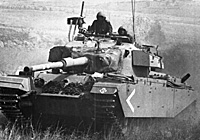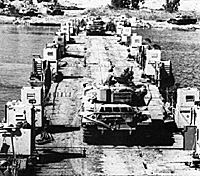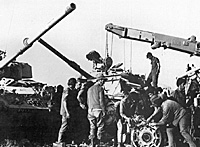
While the original tank was the Mark 5, the Israeli improvements of re-engining and upgunning the basic model have made it the equivalent of the Mk. 10 currently in service with the British Army.
The Centurion has a slightly better rate of fire than the M-48/60 (9-10 rounds per minute compared to 9 rounds per minute) because of the use of the coaxial .50-caliber (12.7mm) machinegun as a spotting rifle. Close coordination between the tank commander and the gunner is not required as the gunner can use the spotting rifle to zero-in with and lay the main gun. However, this method has the disadvantage of disclosing the Centurion's location before the first round from the main gun is fired.
 Centurions in action on the Golan front. Note the turret-mounted Browning M1919 A4 7.62mm MG next to the commander's hatch. (The M-48 Pattons also have this modification.) The company and battalion markings are clearly visible on the tanks, as well as the brigade identification symbol/number on the front left fender in the top picture. The first Centurions Israel
obtained were Mark 3's in 1959-60 with the 20-pounder (83.4mm L/70) gun. Mark 5's were received prior to the 1967 War, with Mark 8 and 9 types purchased after the 6-Day War.
Centurions in action on the Golan front. Note the turret-mounted Browning M1919 A4 7.62mm MG next to the commander's hatch. (The M-48 Pattons also have this modification.) The company and battalion markings are clearly visible on the tanks, as well as the brigade identification symbol/number on the front left fender in the top picture. The first Centurions Israel
obtained were Mark 3's in 1959-60 with the 20-pounder (83.4mm L/70) gun. Mark 5's were received prior to the 1967 War, with Mark 8 and 9 types purchased after the 6-Day War.
Not all Centurions had been converted to diesel engines by the October War. The 79th Reserve Brigade had some still equipped with the old gasoline engines.
 Modified Israeli M-48's and Centurions cross the Suez Canal to the West Bank in the latter stages of the war.
Modified Israeli M-48's and Centurions cross the Suez Canal to the West Bank in the latter stages of the war.
The most heavily armored tank in the Israeli Army, it was their favorite. They have been using the Centurion the longest of any of the main battle tanks, the gun optics and fire control systems are battle-proven and tested, and the crews are very familiar with its operation. In addition to replacing the engine, the Jews also replaced the transmission, steering mechanisms and brakes, improving component reliability, ease of maintenance, speed (from 22 mph to 27 mph), and range (by 300%). There is also the commonality of parts with the M-48/60 to facilitate logistic support.
Although not having as much crew space as the M-48/60, its crew fatigue factor was still far less than the Arab-manned Soviet tanks. Having a shorter silhouette than either the M-48 or M-60 (2.96 meters as opposed to 3.26 meters), the Centurion provided less of a frontal target to Arab gunners.
 Availability: Ease of maintenance and a skilled, efficient service echelon can mean the difference between one more battle-ready tank or 50 tons of scrap steel.
Availability: Ease of maintenance and a skilled, efficient service echelon can mean the difference between one more battle-ready tank or 50 tons of scrap steel.
Age is the Centurion's greatest liability. Not many more modifications can be incorporated into the 29-year-old design to keep it competitive with currently-designed main battle tanks.
Overall, the Centurion, as the Israelis have modified it may be rated as having excellent destructiveness, good survivability, and good availability. It appears to have been the best main battle tank of the war.
More Arab-Israeli Armor 1973
-
Arab-Israeli Armor 1973: Introduction
Arab-Israeli Armor 1973: T-54/55/62
Arab-Israeli Armor 1973: M-48/60
Arab-Israeli Armor 1973: Centurion Mk 5
Arab-Israeli Armor 1973: TO&E
Arab-Israeli Armor 1973: Jewish Tank Markings
Arab-Israeli Armor 1973: Tanker Crew
Arab-Israeli Armor 1973: Comparative Data (Chart)
Arab-Israeli Armor 1973: Comparative Ammunition
Arab-Israeli Armor 1973: Observations and Conclusions
Arab-Israeli Armor 1973: Paper Tanks
Arab-Israeli Armor 1973: Bibliography
Arab-Israeli Armor 1973: Glossary of Terminology
Arab-Israeli Armor 1973: 1/64 Scale Illustrations (extremely slow: 439K)
Back to Conflict Special Study 1 Table of Contents
Back to Conflict List of Issues
Back to MagWeb Master Magazine List
© Copyright 1975 by Dana Lombardy
This article appears in MagWeb (Magazine Web) on the Internet World Wide Web.
Other military history articles and gaming articles are available at http://www.magweb.com